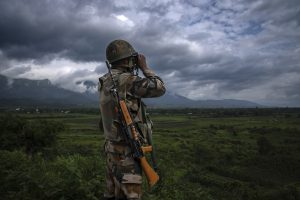As the northeast Indian state of Manipur teeters on the brink of civil war, India’s plans to improve overland connectivity and trade with Myanmar and beyond to other Southeast Asian countries as part of its Act East Policy (AEP) have been dealt another blow, with the prospects of peace and stability in the region, which are needed to boost economic activity, rather bleak.
“The current situation of instability in Manipur has cast a long shadow on AEP in two ways,” Angshuman Choudhury, associate fellow at the Centre for Policy Research, New Delhi, told The Diplomat. “One, it has physically destabilized a critical transregional, cross-border connectivity route that connects India with Myanmar and onward to Southeast Asia; and two, it has generated social, political and economic volatility, which will in turn, dissuade stakeholders from making crucial AEP-linked investments in the Northeast,” he said.
India’s Northeastern states play a key role in India’s AEP; four states share land borders with Myanmar. If the Northeast is India’s “land bridge to Southeast Asia, Manipur is the main gateway to Southeast Asia,” an official in India’s Ministry of Development of North East Region (MDONER) told The Diplomat.
Choudhury points out that the Moreh-Tamu border crossing in Manipur-Sagaing Region, and the Zokhawthar-Rikhawdar border crossing in Mizoram-Chin State are “historical entrepôts to Southeast Asia from the South Asia side.”
“Several trading communities are active on both sides of the border,” he said, stressing that it “makes the most sense to leverage these pre-existing local networks to strengthen transregional connectivity within the AEP framework.”
However, India’s Manipur “gateway” to Southeast Asia is now in flames.
Since May 3, when clashes erupted between the majority Meitei and minority Kuki communities, Manipur has been convulsed in violence. Over 130 people have been killed so far. Several incidents of rape and gang rape have come to light. Entire villages have been torched and nearly 60,000 people have been displaced.
Additionally, police armories have been looted and over 4,000 weapons, including assault rifles, light machine guns, mortars and carbines, and ammunition are reportedly still in the hands of mobs.’
The possibility of the revival of militancy in this once insurgency-wracked state cannot be ruled out. Manipur is staring at a long period of violence and instability.
Manipur is no stranger to violence. Since 1949, when it became a part of the Indian Union, scores of anti-India insurgent groups have battled in the Indian state. Manipur was not alone in this regard; all of the Northeast was roiled in insurgencies, unrest, instability, rising criminality and a thriving narcotics trade. The region was trapped in underdevelopment and poverty.
Development of the economies of India’s Northeastern states by improving their connectivity and access to Southeast Asian markets was among the main factors behind the eastward drive in India’s foreign policy since the 1990s. In 1992, India adopted a Look East Policy, which was relaunched in 2014 as an Act East Policy.
Indian efforts to build overland connectivity with Southeast Asia, however, failed to take off due to multiple insurgencies in India’s Northeast and political instability in neighboring Myanmar.
However, things began to look up over the past decade, with insurgencies in Northeast India winding down and Myanmar transitioning into a quasi-democracy. Road-building and other projects were set in motion.
Even then, overland connectivity projects moved at a snail’s pace. “Except for an unfinished train link and a partially complete Asian Highway that can potentially link Manipur to mainland Southeast Asia through Myanmar” little infrastructure development has happened to take forward the LEP, Rajen Singh Laishram, professor at Manipur University, said.
Recent developments have hit projects hard. Since the military coup in Myanmar in February 2021, the country has been roiled in civil war. And Manipur is now burning. India’s overland route via Manipur and Myanmar to Southeast Asia has been thus rendered unviable.
Of course, India could explore routes through Mizoram, Nagaland and Arunachal Pradesh, the three other northeastern states that also share land borders with Myanmar.
“The Nagaland and Arunachal borders are way too rough and inaccessible for any government to build heavy-duty road connectivity” into Myanmar, Choudhury said.
Worryingly, the flames of unrest and instability are spreading to other parts of the Northeast.
Recently, India’s Foreign Minister S. Jaishankar said that the 1,400-km long India-Myanmar-Thailand Trilateral Highway has been a “very difficult project” – its completion has missed several deadlines – because of the situation in Myanmar.
The situation in Manipur will make it even more difficult.

































